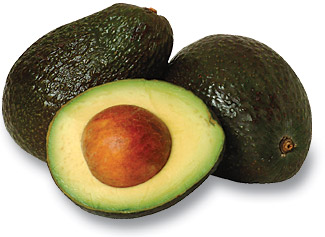
The following article was submitted by contributing writer: Norma Vega.
Yet another fruit from the Americas! First the sinful orb-the tomato-then the dirty orb-the potato-now the testicular one: the avocado! Yes, avocado in náhuatl, the language of the Aztecs is , ahuacatl, which means testicle or ball sack, a direct reference to the way avocados hang –at many times as a pair of orbs- that evidently reminded the ancient Mexicans of the male anatomy! It’s easy to see why Aztec society thought avocados were an aphrodisiac and a fertility fruit.
The delectable avocado is the butter of all fruits! Its high fat content (the fat your body needs in the form of Omega 3 and 6 fatty acids) was consumed by Europeans as they traversed in their galleons between America and Europe. This member of the oil berry family is another fruit originally grown in Mexico and Central America, as well as the northern regions of South America. The British even gave it the name of alligator pear, a direct reference to the fruit’s leathery exterior. In other parts of the world it’s referred to the American Pear, and in India they call it Butter Fruit.
In Mexico the leaves of the avocado tree are used to cook with, providing an anise-like flavor to dishes. And while many, in this part of the world, might want to add a dash of salt to avocado slices, Brazilians eat them as a dessert by adding sugar to it. In Brazil, as well as India, for example, shakes and smoothies —‘batidos’ or ‘licuados’ in Spanish— include ones made with avocado. Then there’s the famous avocado mash called guacamole, another creation of the Aztecs called ahuacamolli (‘ahua‘, which refers to the fruit and *‘molli’: which refers to ‘sauce’ in náhuatl).
So the next time you see a couple of dangling avocados hanging in your tree, let your mind rest on a very particular image and smile at nature as she offers us –with a sense of humor– the ambrosia of all fruits, the avocado.
*The term ‘mole’, the famous Mexican sauce made with a variety of chiles developed in the culinary centers of Mexico, Puebla and Oaxaca, comes from the náhuatl, molli.
AVOCADO SHAKE RECIPE: We thought we’d introduce a twist to the typical avocado recipes typically seen in Mexican or Latino kitchens. The following is a recipe a friend shared with us for an avocado shake, popular in Brazil as mentioned above as well as Southeast Asian cuisine. In Vietnam, like elsewhere in Southeast Asia, avocados are used for sweets. Most often times, the flesh of this rich berry is combined with condensed milk, which amplifies the avocado flavor.  Give it a try! It’s a refreshing drink for the heat of summer.
Give it a try! It’s a refreshing drink for the heat of summer.
Makes about about 2 1/4 cups, enough to serve 2 or 3
1 ripe medium avocado (6–8 ounces)
1 cup ice (8 ice cubes)
1/3 cup sweetened condensed milk
1/4 to 1/2 cup milk
Scoop the avocado flesh into a blender. Add the remaining ingredients, starting out with the least amount of milk and puree until completely smooth. Taste and add additional milk, depending on the avocado type and if a thinner consistency is desired.
Notes:
Some people use a combination of condensed milk (e.g., ¼ cup) and add sugar (1 to 2 tablespoons) to taste. It’s really up to you. The shake tastes better (the buttery, grassy avocado flavor becomes more pronounced) if it sits for a bit, say 10 to 15 minutes in the fridge.
